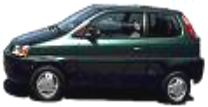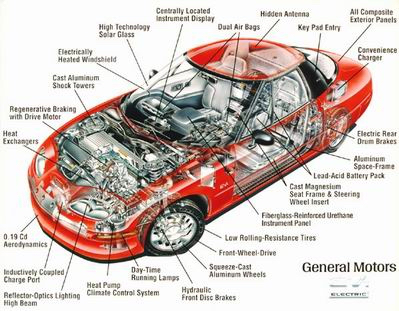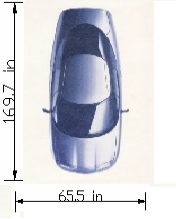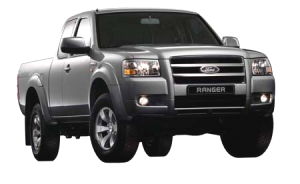25%; text-indent: -10.5pt; font-family: Tahoma; font-size: 11pt; margin-bottom: 0pt; margin-left: 10.5pt; -ms-layout-grid-mode: char;">¨Payload: 1250 lb/567kg. (GVW 5350 lb/2427 kg).
Estimated Range:
¨90 miles (Est., 145 km.) metro/highway.
¨(Customer range is approximately 68-85 miles (104.6-136.8 km), depending on climate and driving conditions. Range may decrease to 45miles (72.4 km) with full operation of heater).
2.3 Honda EV Plus
The Honda EV Plus is a purpose-built electric vehicle, not a conversion of an existing gasoline powered car, as shown in Figure 2.4. It is a two-door hatchback, with four seats. The rear seats fold down for increased cargo space. The car seats fold plant as the Acura NSX sports car. Honda plans to lease about 400 EV+ cars in California in 1998 in order to evaluate the driving habits and customer lifestyles potential EV owners. The EV+ is not for sale; it is available only through Honda’s 36-month “Charter Lease Program”.

Figure4 Honda EV Plus
2.3.1 Performance
¨Range: EPA city driving is 100 miles (160.9 km), high-way 84 miles (135.2 km).
¨Acceleration: 0-30 in 4.9 seconds, 0-60 in 17 seconds (the car’s performance is also quite good).
¨Top speed: >80 mph (129 km/h).
2.3.2 Drive train/Batteries/Charging
¨Motor: high-efficiency, permanent magnet. Power output: 49 kW (approx 66 hp) at 1700-8500 r/min; torque is 275 N*m at 0-1700 r/min.
¨Transmission: 1 speed, direct drive.
¨Charger: on board (110V or 220V power supply).
¨Recharge time: 6-8 hours (220V from 80% discharge). Honda required EV+ owners to install a 220V regulated/isolated power supply in their garage for charging the vehicle (installation cost was $ 1905.00).
2.3.3 Chassis/Suspension
¨Front wheel drive, unit-body construction w/integrated large cross-section straight frame rail.
¨Front strut/rear beam suspension.
¨Electric, variable power-assist rack and pinion steering.
¨Grade-sensitive regenerative braking with ABS (regeneration allows you to “recapture” expended power on downhill runs by using the motor as a generator, thus extending the car’s effective range).
¨14 in (355.6 mm) alloy wheels with low-rolling resistance 195/65 R14 tires.
2.3.4 Comfort/Convenience
¨Power windows, doors, mirrors, with automatic climate control for heating and cooling (the car has a “heat-pump” style climate system).
¨AM/FM/CD: multi-function remote (you can “precondition” the cabin temperature or read how charged the batteries are from the remote!) with keyless entry to arm/disarm the security system.
¨Heat-reflecting glass. A friendly walk-in feature for rear seat access (and a flat floor to increase rear seat legroom), with split-folding rear seatbacks.
2.3.5 Safety/Security
¨Dual airbags with 3-point belts at seating positions.
¨Theft-deterrent system.
¨Under floor battery pack layout is protected by frame rails.
¨Isolated electric-power control systems.
¨Intelligent crash-detection system disconnects all propulsion power.
¨Energy-saving high-performance gas-discharge headlights.
2.3.6 Exterior/Interior Dimensions
¨Wheelbase: 99.6 in (2529 mm).
¨Length: 159.3 in (4046.22 mm).
¨Height: 64.2 in (1630.68 mm).
¨Width: 68.9 in (1750.06 mm).
¨Track (f/r):59.1/58.7 in (1501.14/1490.98 mm).
¨Curb weight: 3590 lb (1628.40 mm).
¨Headroom (f/r):59.1/58.7 in (1501.14/1490.98 mm).
¨Legroom (f/r):41.9/34.2 in (1064.26/868.68 mm).
¨Shoulder room (f/r):53.2/51.9 in (1351.28/1318.26 mm).
¨Cargo space: 11.5 cu.ft (3325.64 dm3).
¨Interior passenger volume: 89.1 cu.ft (2523.03 dm3).
¨Carrying capacity: 700 lb (317.5 kg, passengers and cargo combined).
2.3.7 Lease Terms/Purchase
The Charter Lease Program is a 36 month, all-inclusive lease. The lease include all maintenance, 24/7 roadside assistance, collision and comprehensive insurance (the lessee must provide liability insurance only), and use of a loaner if the car is kept for service. The Northern California lease price is currently $ 454/month, and there is no buy-out option at the end of the lease.
The car carried a sticker price of $ 53999, although you cannot purchase the car, the car is eligible for $ 4000 in federal tax credits, and $ 5000 in California and Bay Area tax incentives (Honda uses this $ 9000 to reduce the lease price to $ 454/month).
Comparison of some features of GM EV1, Ranger and EV Plus is shown in table 1.
|
Table1 Comparison of some feature of EV1, Ranger and EV Plus
|
|
Manful
|
Power train
|
Battery
|
range
|
Top speed
|
Charge
|
|
GM EV1
|
3 phase, A
C induct-
on electr-
ic motor
|
26valve-regulated lead-acid module:
Ni-MH
|
55-95miles(88.5-152.9km)Per charge (lead-acid);
75-130miles(12.7-209.2km)Per charge (Ni-MH)
|
80mph
(129km/h)
|
Indoor
charging
|
|
Ford Range
|
3 phase, A
C motor
|
lead-acid Ni-MH
|
77 miles (123.9km)
|
75mph (120km/h)
|
On board
|
|
Honda EV Plus
|
Permanent
Magnet
|
24/12-volt Ni-MH
|
100miles (1160.9km)
|
>80mph
(129km/h)
|
On board
|
, 外文翻译
Battery Electric Vehicle
1、 Technical Overview of Electric Vehicle
The advantage of the EVS is the mechanical simplicity of the drive train. For example, an EV drive train can convert energy stores into vehicle motion, just like a conventional vehicle, and it can also reverse direction and convert vehicle motion back into energy stores through regeneration barking, which means that theirs energy/work loop is inherent bi-directional. Besides, moving parts of the electric motor in the EVS consist primarily of the armature (DC motors) or rotor (AC motors) and bearings, a relatively simple and far more efficient machine. other advantages include electric motor torque much more suited to the torque demand curve of a vehicle. EV drive train often needs only one gear ratio other than two or more. More-over, a reverse gear is unnecessary because the rotational direction of the motor itself can be reversed simply by reversing the electrical in-put polarity.
However, the function capabilities and the cost/benefits profile of electronic system are rather complicated. Electrical power is delivered to the wall outlet in the form of alternating current, and must be converted into direct current in order to charge EV batteries. In the case of EVs powered by DC motor, electricity from the battery must then be “chopped” into small bursts of variable duty cycle in order to control the speed and torque of the motor. With EVs using AC motors, the direct current from the battery must undergo complex power condition in order to deliver alternating current and provide control over motoring output. The main disadvantage of BEVS is limited energy stores due to the limitations of the secondary battery, and HEVS tend to be plagued by increased mass and costs due to the increased complexity of the power system.
2、 Battery-power Electric Vehicle (BEV)
For the battery-power electric vehicles, there is either a purpose-built EV or a conversion of an existing gasoline powered vehicle. Some of the EVS, such as GM EV1, Ford Ranger and Toyota Prius will be shown below.
2.1 GEN11-General Motor EV1
The next generation GM EV1 is a purpose-built electric vehicle with software upgrades, refine ride and handling, impotents of GM EV1 is shown in Figure2.1.For the first time, the EV1 offers two battery technologies; an advanced, high capacity lead-acid, and an optional nickel-metal hydride.
2.1.1 Propulsion/Electronics
¨Configuration: Transverse-mounted, front-wheel drive.
¨Motor Type: Three-phase, alternating current (AC) induction.
¨Power Rating: 102 kW (137 horsepower) at 7000 r/min.
¨Transaxle Type: Single-speed with dual reduction gears.
¨Power Management System; Insulated gate bipolar transistor (IGBT) power inverter.

Figure1 Components of GM EV1
¨Battery Packs:
Standard: 26 valve-regulated high-capacity lead-acid modules.
Optional: 26 valve-regulated nickel-metal hydride modules.
¨Rated Maximum Battery Pack Storage Capacity:
Standard: High-capacity lead-acid battery-pack-18.7kW*h/60A*h (312 volts).
Optional: Nickel-metal hydride battery-pack-26.4kW*h/77A*h (343 volts).
Battery packs Weight:
Standard: High-capacity lead-acid battery-pack-594.21kg.
Optional: Nickel-metal hydride battery-pack-520.27kg.
¨Charges and Charge Port: Listed by Underwriters Laboratories Inc.
¨Battery Pack, Charging System and Vehicle: Classified by Underwriters Laboratories for indoor charging.
2.1.2 Body/Chassis
¨2-passenger coupe.
¨Body Type: Aluminum alloy structure jointed with welds, rivets and structural adhesive.
¨Dent/Corrosion-Resistant Composite Exterior Panels: Hood, doors, roof and trunk lid (Sheet Molding Compound (SMC));front fenders, rear quarter panels, rocker panels, rear-wheel skirts, aerodynamic belly pan (Reinforced Reaction Injection Molding(RRIM) polyurethane).
¨Body panels are 100% recyclable and very lightweight.
2.1.3 Suspension
¨Front Suspension: Aluminum short/long arm with coil spring over shock absorber with stabilizer bar.
¨Rear Suspension: Multi-link aluminum beam with Pan hard rod.
2.1.4 Steering
¨Steering Type: Electro-hydraulic, power rack-and-pinion (speed-sensitive, variable-effort).
¨Steering Ratio: 16.5:1.
¨Turning Diameter: 32.5 ft (10.21m).
¨Steering wheel Turns: 3.0(lock-to-lock).
2.1.5 Braking System
¨Braking System: Electro-hydraulic, power-assisted front and electric rear with blended regenerative and anti-lock features.
Front: 9.65 in (245.11 mm) solid discs with aluminum calipers.
Rear: 8.9 in (226.06 mm) metal-matrix composite drums with electric actuation.
¨Park brake: Electric actuation with gear selector, or push button.
2.1.6 Wheels
¨Wheels: 14 in (355.6mm) aluminum alloy.
¨Tires: P175/65R14 Michelin Proximal; all-season radial with self-sealing, puncture-resistant feature.
2.1.7 Safety Features
¨Anti-lock braking system.
¨Traction control.
¨Check tire pressure system.
¨Air bags and three-point shoulder/lap seatbelts.
¨Projector low beam/reflector optic high beam headlights.
¨Daytime running lamps(DRL).
¨Electronic keypad entry/vehicle activation system with programmable personal identificati-on number.
¨Electric windshield defogger/deicer.
¨Electric rear window defogger with automatic shutoff.
2.1.8 Comfort/Convenience Features
¨Power windows, door locks and dual outside mirrors.
¨Cruise control with downgrade and upgrade speed regulation.
¨Premium AM/FM stereo with cassette and CD player, four speakers and digital clock.
¨Computer-controlled “heat pump” climate control system with preconditioning feature and CFC-free air conditioning refrigerant; new electric heater.
¨Center-mounted vacuum fluorescent instrumentation.
¨Interior courtesy lights with delayed shutoff feature.
¨Solar reflective/absorptive glass.
¨Intermittent windshield wipers with washer system.
¨Remote hood and trunk lid releases.
¨Four-way adjustable bucket seats with lightweight alloy frames.
¨Carpeted floor mats.
¨Carpeted cargo area with cargo net.
2.1.9 Performance
¨0-60 mph (0-96.56km/h) acceleration in less than 9 seconds.
¨Electronically regulated top speed of 80 mph (128.75km/h).
¨0.19 aerodynamic dray coefficients (25% lower than any other production car).
¨Estimated Range:
Standard: High-capacity lead-acid battery pack-55-95 miles (88.51-152.89 km) per charge.
Optional: Nickel-metal hydride battery pack-75-130miles (120.70-209.21) per charge.
¨Estimated Energy Consumption Information (kW *h per 100 miles):
Standard: High-capacity lead-acid battery pack-26city/26 highway.
Optional: Nickel-metal hydride battery pack-34city/30highway.
¨Estimated Time from Zero to Complete State of Charge at 70 degrees with normal humidity:
Standard: High-capacity lead-acid battery pack-5.5 to 6 hours using the 220volt (6.6kw)
Charger; 22 to 24 hours using the 110volt (1.2kw) convenience charger.
Optional: Nickel-metal hydride battery pack-6 to 8 hours using the 220volt (6.6kw) charge.
 ¨60-0 mph braking distance of 160 feet (48.77m).
¨60-0 mph braking distance of 160 feet (48.77m).
¨Size (Figure 2.2):
Wheelbase: 98.9 in (2512 mm).
Length: 169.7 in (4310 mm).
Width: 69.5 in (1766 mm, overall).
Height: 50.5 in (1282 mm).
Track (front):49.0 in (1270 mm).
Track (rear):49.0 in (1244 mm).
Vehicle Curb weight: Led-acid: 3086 lb (1400 mm).
Ni-MH: 2908 lb (1320 mm).
¨Min. ground clearance: 5.0 in Figure2 GM EV1 (127mm). Figure2 GM EV
¨Head room: 37.6 in (955 mm).
¨Shoulder room: 54.4 in (1381 mm).
¨Leg room: 42.6 in (1083 mm).
¨EPA passenger capacity: 50.4 cu.ft 2.2 (1427 mm).
¨EPA cargo volume.9.7 cu.ft 2.2 (275 liters).
2.2 Ford Ranger
Vehicle Specifications (Figure3):

Figure3 Ford Ranger
¨ZEV (Zero Emission Vehicles).
¨Lead-acid and nickel-metal hydride battery types available.
¨112 in (2845 mm) wheelbase.
¨90 horsepower (67.1 kW), 140 ft-lb (190 N*m) torque, high efficiency, 3-phase AC motor.
¨Single-speed, rear-wheel-drive transaxle.
¨Customer Range: NI-MH: 65-80 miles (105-129 km).
¨low-rolling-resistance tires.
¨Driver & passenger side airbags.
¨4-wheel ABS and regenerative barking.
¨Ni-MH 1250 lb (567.0 kg) Pb-A 650 lbs (294.8 kg) pay-load.
¨Conductive on-board charging.
¨Lightweight aluminum wheels.
Battery Capacity:
¨23 kW*h (18 kW*h at 85% discharge).
Estimated Range:
¨77 miles (124 km/h) metro/highway.
(Customer range is approximately 50 miles (80.5 km), depending on climate and driving conditions.)
Rated Top Speed:
¨75 mph (120 km/h) in drive mode (governed).
¨65 mph (105 km/h) in economy mode.
0-50 Miles per Hour:
¨12.5 seconds.
Vehicle Features:
¨Short wheelbase, regular-cab, style side body style.
¨90 hp (67.1 kW), high-efficiency, 3-phase AC motor.
¨Single-speed, rear-wheel-drive transmission.
¨4-wheel anti-lock brakes and regenerative braking.
¨700 pounds (317.5 kg) payload.
¨Dual air bags.
¨Electro hydraulic power steering.
¨On-board charging.
¨Climate control.
¨Lightweight aluminum wheels.
¨Low-rolling-resistance tires.
Ranger Electric Vehicle Fuel Specifications (Ni-MH):
New for 1999, Ford is offering the Ranger Electric Vehicle with a nickel-metal hydride (Ni-MH) option. The Ni-MH Ranger EV can also carry an improved payload up to 1250 lb (567 kg).
Specifications:
¨25 Ni-MH 112-volt Modules; 300 volt system.
全套毕业设计论文现成成品资料请咨询



